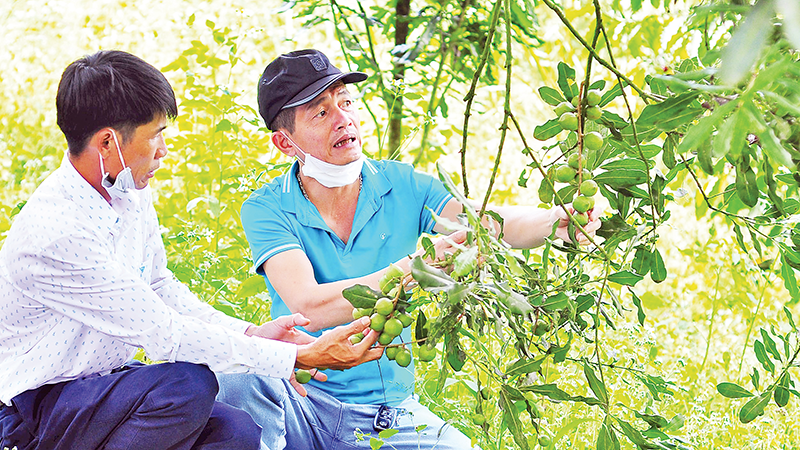Sustainable development of macadamia
Lam Dong has advantages in soil and a temperate climate and is undergoing strong transformation in modern agriculture. Among these, macadamia has emerged as a new key crop, contributing to the promotion of sustainable agricultural growth, improving farmers’ incomes and responding to climate change.

Lam Dong is the leading locality in the country in terms of macadamia planting area and productivity. (Photo: nhandan.vn)
At present, the whole province has about 16,000 hectares of macadamia, of which around 6,600 hectares are in harvest. The output in 2025 is expected to reach 13,700 tonnes, an increase of nearly 50% compared to 2024. About 80% of macadamia is grown on agricultural land, mainly intercropped with industrial crops; more than 3,000 hectares are cultivated on forestry land, contributing to the target of planting 1 billion trees and protecting the ecological environment.
Practice shows that with intercropped areas, from the 7th year onwards, one hectare of macadamia brings an average profit of 105 million VND. For pure plantations, the average profit is about 170 million VND a ha from the 5th to 6th year and about 350 million VND a ha from the 7th year. With favourable climate and soil conditions, in growing areas such as Di Linh, Hoa Ninh, Dinh Trang Thuong, Nam Ha Lam Ha, and Tan Ha Lam Ha, macadamia achieves yields of up to 30 kg of nuts per tree. To improve product quality, in recent years, the provincial Agricultural Extension Centre has coordinated with relevant agencies, enterprises, cooperatives and farmers to select and produce high-quality varieties.
Currently, Lam Dong has five recognised macadamia mother gardens covering more than 10 hectares, producing 1 million scions per year, together with 36 establishments engaged in seedling production and trading. Popular varieties such as A38, A4, QN1, 800, 816, and 24 have been carefully selected and are highly valued in the market; contributing to meeting the demand for high-yield, high-quality varieties suited to the local soil and climate conditions.
Lam Dong also focuses on developing macadamia processing facilities and commercial products for both domestic consumption and export. The province currently has 75 purchasing and processing establishments with a capacity of about 6,000 tonnes of raw materials per year, mainly producing traditional products such as roasted cracked macadamia nuts and packaged kernels. The province has established nine linkage chains in production, purchase, processing and consumption, with nearly 1,300 hectares and 1,168 households participating, producing more than 1,000 tonnes a year.
Typical linkage chains include Viet Xanh Company, Hoang Anh Macca, Macca Sao Vang and cooperatives. Director of the National Agricultural Extension Centre Le Quoc Thanh assessed that Lam Dong is the country’s leading locality in terms of macadamia area and productivity. Developing macadamia is not only about expanding the planting area but also about improving quality, organising production along the value chain, applying VietGAP standards and building sustainable linkages with processing and consumption enterprises to affirm its position in the international market.
The province has also implemented the project “Developing intensive macadamia cultivation models under VietGAP standards associated with product consumption linkages”, with a scale of 70 hectares, attracting the participation of 140 households. The project provides material support, VietGAP certification costs, planting area codes, labels and technical training for more than 780 farmer participants. At the same time, community agricultural extension groups and cooperative-enterprise linkage models have been established to secure product consumption.
Deputy Director of the provincial Department of Agriculture and Environment Nguyen Ha Loc said: “After nearly 20 years of development, macadamia has affirmed its potential and strengths in agricultural restructuring, increasing farmers’ incomes and improving forest coverage, thereby protecting the environment. The clear planning and orientation from the beginning have created favourable conditions for Lam Dong’s macadamia industry to grow.”
However, the macadamia industry in Lam Dong still faces many challenges, such as uneven seedling quality, high prices of grafted seedlings, limited cultivation techniques, and the long period from planting to harvesting, which reduces attractiveness compared to crops like avocado and durian. In addition, production is still fragmented, with mostly small-scale intercropping, making it difficult to form strong production-processing-consumption linkages; the purchasing and processing system is small-scale and lacks strong connections with enterprises, leading to products not being certified for quality standards; processing technology remains limited; and products lack diversity, being mainly roasted macadamia.
Faced with both opportunities and challenges, Lam Dong aims to develop macadamia towards forming large-scale, concentrated, efficient and sustainable raw material areas. By 2030, the province strives to reach 37,000 hectares of macadamia, including 23,000 hectares on agricultural land and 14,000 hectares on forestry land, achieving an output of about 48,000 tonnes, with more than 90% of production preliminarily processed or processed. Looking ahead to 2050, the cultivation area is set to reach 50,000 hectares with an output of around 90,000 tonnes, thereby establishing a closed value chain from seedling production to export.
According to Nguyen Ha Loc, in order to achieve the set targets and make macadamia a spearhead industry, Lam Dong will prioritise long-term and fundamental measures. These include developing concentrated cultivation areas linked with processing enterprises; encouraging intercropping on agricultural and non-forested forestry land; improving seedling quality with the use of grafted high-yield varieties and strict control of seedling producers; promoting cultivation and harvesting techniques in accordance with VietGAP, GlobalGAP and organic standards; strengthening farmer–cooperative–enterprise linkages to ensure stable raw material supplies; and enhancing trade promotion and supply-demand connectivity.
By 2030, the province aims for over 50% of its macadamia output to be produced and marketed through such linkages. In parallel, Lam Dong will seek to integrate macadamia development policies into national target programmes and promote the “Lam Dong Macadamia” brand.








